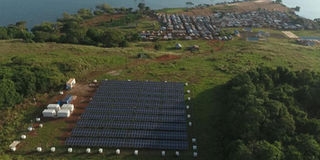Where is the middle ground in pricing electricity on mini grids?

An aerial view of the Kitobo Island Mini grid. Development partners suggest that for future mini grid investments, a fine balance will need to be struck. Courtesy Photo
What you need to know:
Statistics from Electricity Regulatory Authority’s (ERA) distribution tariffs for 2018 indicate that while Umeme charged an average of Shs744.5 to domestic users, mini grids like KRECS charged their domestic consumers Shs615.3
It is without a doubt that mini grids are key in Uganda’s agenda to attain universal access to electricity.
Mini grids are investments developed in areas where government’s electricity, otherwise known as the grid has not yet reached. These, commonly solar energy developments, are usually in far to reach areas, bridging the supply gap to the unreachable communities.
Uganda has several mini grids serving the country such as Kyegegwa Rural Electricity Cooperative Society (KRECS).
The country’s access to electricity said to be at 22 per cent, puts Uganda at the mercy of investors in mini grids whose role is pivotal in boosting this number.
However, to encourage investment in those areas, investors need an incentive which is profit, while the consumers – despite need for electricity – are keen on affordability.
Price
Statistics from Electricity Regulatory Authority’s (ERA) distribution tariffs for 2018 indicate that while Umeme charged an average of Shs744.5 to domestic users, mini grids like KRECS charged their domestic consumers Shs615.3.
At the recently concluded joint energy sector review meeting held in Munyonyo, Mr Cedric Merel, head of cooperation European Union, highlighted the need for government to encourage investment in mini grids to boost access to electricity.
Mini grids
“Mini-grids by definition are a transitory solution until the grid is available country-wide in the long term and thereby a transitory tariff should be accepted that appropriately translates the cost of investments and of the existing energy supply alternatives available to the consumers,” he said.
He added; “Development partners feel that there is no logical base to a comparison in the tariffs between on-grid and mini grid electricity consumption.”
In his explanation, he says the tariffs set for the electricity produced and sold to consumers in those mini-grids will influence the viability of the mini-grids and therefore their existence in Uganda.
The worry, development partners aver, is that if the tariffs are set too low, mini-grids will not be sustainable and will not be an option for those communities, resulting into continued lack of access to power for a considerable amount of time.
The development partners suggest that for future mini grid investments, a fine balance will need to be struck considering; the willingness to pay by consumers, the cost of power alternatives and the prospects of creating new economic activities using power that will bring financial returns to the communities.
It is also critical to gauge the capital and operation costs that will be met in the long term by the private sector.
Subsidies
Mr Riccardo Ridolfi, chief executive officer(CEO), Equatorial Power has five years’ experience in developing mini grids in the country.
Currently, Equatorial Power is developing a mini grid project in Namayingo District, in partnership with a large strategic investor to generate 600Kilowatt peak (kWp) of solar energy.
The project expected to be commissioned during the first half of 2020 will serve 3,700 connections and about 15,000 people along with its own mini industrial park.
According to the developer, while ERA is mandated to apply principles of reasonable cost-reflectiveness when determining the tariff, one cannot treat the national tariff in the same way one might treat tariffs for off-grid investments, like mini grids.
“The national grid is a large system which benefited from structural subsidies from its inception and which benefits from large off-taker clients, enabling economies of scale. The latter is a small isolated system catering to consumers with lower demand, therefore facing higher costs and higher risk,” he says.
Reduce red tape
Government, he says, must enable private investment by reducing red tape and allowing cost-reflective tariffs, which are higher than the national tariff if the country is to gain universal access.
Subsequently, he suggests, this can be lowered with subsidies and other mechanisms if available, towards a lower universal tariff.
In that effort, government through Rural Electrification Agency is mandated to cater for distribution mechanisms to the final consumers upon completion of the mini grid by the private developers.
Commenting on the matter, electricity regulator, ERA explained that its primary focus is on increasing access which factors in affordability to the final consumers.
“You cannot ignore the question of affordability when setting tariffs. However, we should consider increasing access ahead of tariff comparisons. ERA is focused on supporting mini grids to increase access and not stop investors because of tariff comparisons,” Mr Julius Wandera, principle communications manager ERA, said.




